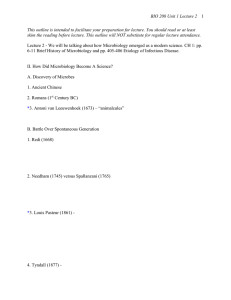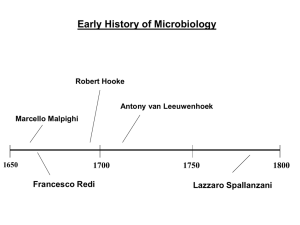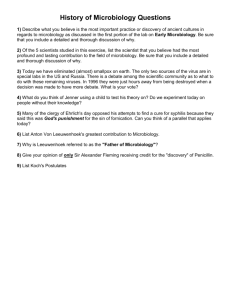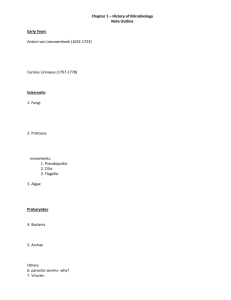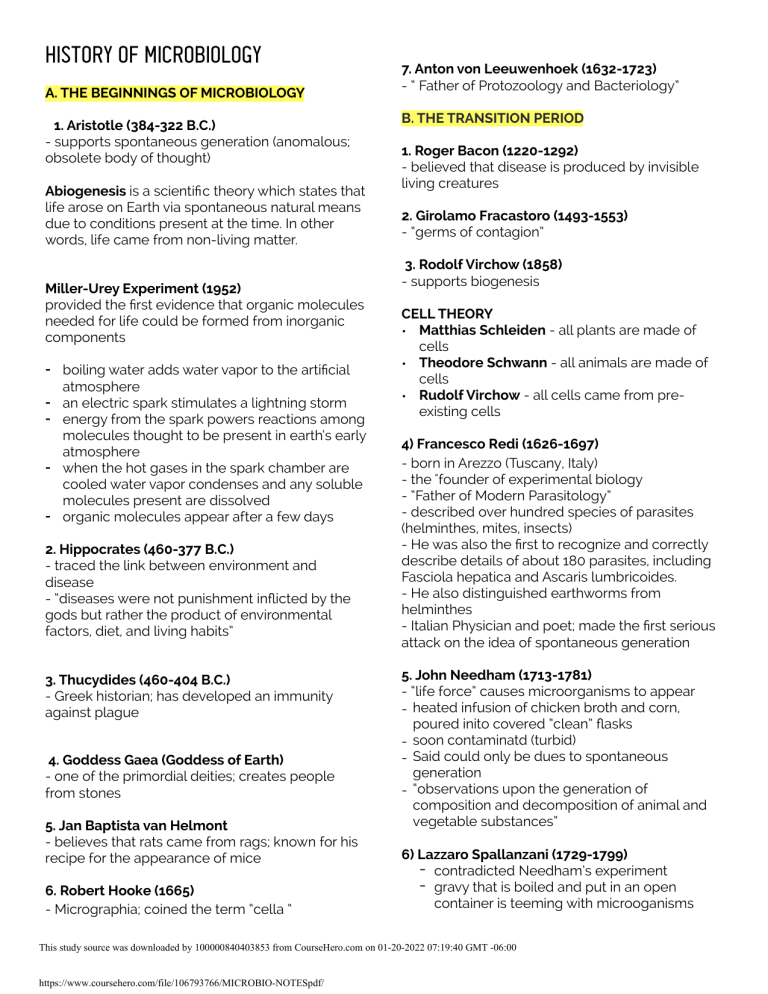
HISTORY OF MICROBIOLOGY A. THE BEGINNINGS OF MICROBIOLOGY 1. Aristotle (384-322 B.C.) - supports spontaneous generation (anomalous; obsolete body of thought) Abiogenesis is a scientific theory which states that life arose on Earth via spontaneous natural means due to conditions present at the time. In other words, life came from non-living matter. Miller-Urey Experiment (1952) provided the first evidence that organic molecules needed for life could be formed from inorganic components ⁃ boiling water adds water vapor to the artificial atmosphere ⁃ an electric spark stimulates a lightning storm ⁃ energy from the spark powers reactions among molecules thought to be present in earth’s early atmosphere ⁃ when the hot gases in the spark chamber are cooled water vapor condenses and any soluble molecules present are dissolved ⁃ organic molecules appear after a few days 2. Hippocrates (460-377 B.C.) - traced the link between environment and disease - “diseases were not punishment inflicted by the gods but rather the product of environmental factors, diet, and living habits” 3. Thucydides (460-404 B.C.) - Greek historian; has developed an immunity against plague 4. Goddess Gaea (Goddess of Earth) - one of the primordial deities; creates people from stones 5. Jan Baptista van Helmont - believes that rats came from rags; known for his recipe for the appearance of mice 6. Robert Hooke (1665) - Micrographia; coined the term “cella ” 7. Anton von Leeuwenhoek (1632-1723) - “ Father of Protozoology and Bacteriology” B. THE TRANSITION PERIOD 1. Roger Bacon (1220-1292) - believed that disease is produced by invisible living creatures 2. Girolamo Fracastoro (1493-1553) - “germs of contagion” 3. Rodolf Virchow (1858) - supports biogenesis CELL THEORY • Matthias Schleiden - all plants are made of cells • Theodore Schwann - all animals are made of cells • Rudolf Virchow - all cells came from preexisting cells 4) Francesco Redi (1626-1697) - born in Arezzo (Tuscany, Italy) - the "founder of experimental biology - “Father of Modern Parasitology“ - described over hundred species of parasites (helminthes, mites, insects) - He was also the first to recognize and correctly describe details of about 180 parasites, including Fasciola hepatica and Ascaris lumbricoides. - He also distinguished earthworms from helminthes - Italian Physician and poet; made the first serious attack on the idea of spontaneous generation 5. John Needham (1713-1781) - “life force” causes microorganisms to appear - heated infusion of chicken broth and corn, poured inito covered “clean” flasks - soon contaminatd (turbid) - Said could only be dues to spontaneous generation - “observations upon the generation of composition and decomposition of animal and vegetable substances” 6) Lazzaro Spallanzani (1729-1799) - contradicted Needham’s experiment - gravy that is boiled and put in an open container is teeming with microoganisms This study source was downloaded by 100000840403853 from CourseHero.com on 01-20-2022 07:19:40 GMT -06:00 https://www.coursehero.com/file/106793766/MICROBIO-NOTESpdf/ 7. Edward Jenner (1798) - introduces vaccination or immunization 3. Louis Pasteur (1822-1895) - “Father of Microbiology” • While studying rabies, Pasteur tested his first 4. Edward Buchner (1860-1917) - demonstrated acellular fermentation human vaccine. Pasteur produced the vaccine by attenuating the virus in rabbits and subsequently harvesting it from their spinal cords. Louis Pasteur performing an experiment. • Pasteur reasoned the factor that made the bacteria less deadly was exposure to oxygen. The discovery of the chicken cholera vaccine by Louis Pasteur revolutionized work in infectious diseases and can be considered the birth of immunology. 8-9. Franz Schulze (1815-1873) and Theodor Schwann (1810- 1882) - air sterilized in flames 10. Heinrich Schroder and Theodor von Dusch (1850) - filtered the air entering the cultured flask through cotton 11. Ignaz Philipp Semmelweis (1818-1865) - among the first to correlate hand washing with the prevention of disease spread; uses chlorinated lime water 12. John Snow (1813-1858) - correlated the spread of cholera in Broad St. London 5. Joseph Lister (1860’s) - “Father of Antisepsis” - introduced the principles of sterile surgery in his practice; uses carbolic acid 6. Robert Koch (1843-1910) - “Father of Microbiological Laboratory” - verified the germ theory of disease Koch’s Postulates 1. The “suspected causative agent” must be present in every case of the disease and absent from healthy hosts. 2. The agent must be isolated and grown outside the host. 3. When the agent is introduced into a healthy, susceptible host, the host must get the disease. 4. The same agent must be re-isolated from the diseased experimental host. Practical and Ethical Limits of Koch’s Postulates 1. Some MQS have unique culture requirements. 2. The use of alternative methods of culturing and detecting certain MQS. C. THE CLASSICAL GOLDEN AGE OF MICROBIOLOGY (1854-1914) 3. Some infectious diseases are not as clear cut. 1. Florence Nightingale (1820-1914) - organizes hospitals which minimizes cross infection - aseptic precautions - “Do the patient no harm” 4. Human host exhibits certain signs and symptoms that are associated with certain pathogen and its disease. 2. John Tyndall (August 2,1820–December 4, 1893) - developed Fractional Sterilization to kill spores Tyndallization (Stop-Start Sterilization or Fractional Sterilization) a. Steam heating (1000C for 30 minutes) b. Incubate overnight (30-370C) c. Second heat treatment (1000C for 30 mins.) d. Second Incubation overnight (30-370C) e. Third heat treatment (1000C for 60 mins.) 5. Other infectious diseases have poorly defined etiologies. 6. Some pathogens can cause several diseases. 7. Ethical considerations. 7. Hans Christian Gram – introduced the gram staining procedure D. The Second Golden Age of Microbiology (1943-1970) This study source was downloaded by 100000840403853 from CourseHero.com on 01-20-2022 07:19:40 GMT -06:00 https://www.coursehero.com/file/106793766/MICROBIO-NOTESpdf/ 1. 1932 - invention of electron microscopes 2. 1940’s - birth of molecular genetics 3. 1929,1941 - antibiotic cures diseases a. Paul Ehrlich (1910)- first to synthesized Salvarsan “magic bullets” b. Gerhard Domagk (1932) - discovered Sulfonamides c. Selman Walksman - coined the term “antibiotic” E. The Third Golden Age of Microbiology - NOW or The Modern Age Gram Lister Nightingale Jenner von Behring Kitasato Ehrlich Fleming 1. Molecular Biology - “gene sequencing” 2. Recombinant DNA Technology - genetic engineering” 3. Gene Therapy - inserting and repairing a defective gene 4. Challenges of Microbiology a. Antibiotic Resistance - “supermicrobes” b. Emerging and Re-emerging Infectious Diseases c. Bioterrorism The Golden age of microbiology Biologists Disciplines Leeuwenhoek Bacteriology (bacteria), Protozoology (protozoa), Mycology (fungi), Parasitology (protozoa and animals), Phycology (algae Taxonomy Linnaeus Semmelweiss Snow Pasteur Koch Ivanowski Beijernck Winogradsky Infection control and Epidemiology Industrial microbiology (Pasteurization) Food and beverage technology (Koch’s postulates) Etiology Virology Environmental microbiology Ecological microbiology This study source was downloaded by 100000840403853 from CourseHero.com on 01-20-2022 07:19:40 GMT -06:00 https://www.coursehero.com/file/106793766/MICROBIO-NOTESpdf/ Powered by TCPDF (www.tcpdf.org) microbial morphology Antiseptic medical techniques, Hospital microbiology Serology, Immunology Chemotherapy Pharmaceutical microbiology
